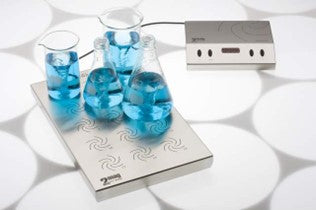Spend any time in a lab, and you’ll use magnetic stirrers to mix solutions and disperse reagents. A magnetic stirring system will consist of a small stirrer bar (of varying shapes and sizes) and a magnetic base that allows users to control the speed.
Magnetic stirrers often perform at a high level, but you may sometimes need to address certain issues with your stirring system. Here are 3 troubleshooting issues with magnetic stirrers and solutions to fix them.
1. Your Magnetic Stirrers Stop Spinning
Sometimes, your magnetic stirrer will simply stop spinning. Unless you’re working with a viscous solution, the bar has likely become uncoupled from its magnetic base.
Simply remove your glassware, allow the spinner bar to return to the vessel's center, then put it back on the stirrer base. This time, increase the speed slowly until you reach the desired speed.
It may be that the spinner bar itself is not properly matched to the magnetic base. Check the manufacturer’s specifications, which will tell you the ideal dimensions for the spinner bar.
2mag stirring systems integrate features that help resolve this troubleshooting for you and make long-term use a breeze. 2mag SoftStart is undoubtedly invaluable for all stirring applications.
2. Your Magnetic Stirrers Spin Too Slowly or Get Stuck
If you’re working with a particularly viscous solution, your spinner bar may have difficulty spinning at an adequate speed. In some cases, it may even get stuck. When this happens, there are three things you might try.
First, you might try to use a different size spinner bar. A shorter bar will have an easier time spinning in the solution, though this may not be ideal for larger volumes.
Secondly, you might try to use a more powerful magnetic base. A stronger base might help you stir solutions of greater density without the bar becoming bogged down by the thicker fluid.
Third, you might consider using a different vessel altogether. If your stir bar is having trouble mixing the contents of a volumetric flask, consider using a smaller piece of glassware and mixing smaller batches of your desired mixture.
3. Your Solution Is Unevenly Mixed
In some cases, your stir bar may spin at an adequate speed, but you find that your solution is not mixing evenly. Even mixing is particularly important if you’re working with suspensions whose components need to be equally dispersed throughout the container.
If this happens, try to use a different spinner bar entirely. A longer spinner bar can provide more consistent mixing and dispersion; just make sure that the length doesn’t exceed the specifications of the stirring base.
You can also try a stir bar of a different shape. Triangular stir bars, for example, are ideal for creating a lot of turbulence inside the vessel, which will prevent sediment from sinking to the bottom.
Putting the Right Spin on Your Lab Work
Your magnetic stirring system may seem minor, but it contributes a great deal to the accuracy of your lab results and enhances your overall working experience. Knowing how to resolve these issues can mean a better working environment, as well as more reliable data.

